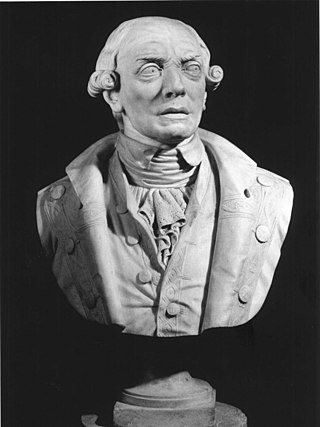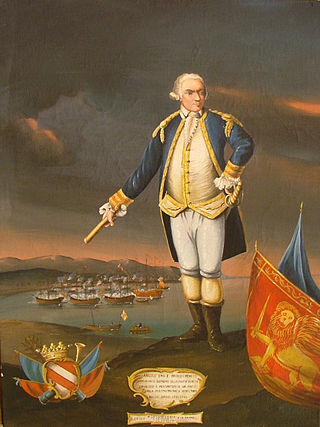
The Third Battle of the Dardanelles in the Fifth Ottoman-Venetian War took place on 26 and 27 June 1656 inside the Dardanelles Strait. The battle was a clear victory for Venice and the Knights Hospitaller over the Ottoman Empire, although their commander, Lorenzo Marcello, was killed on the first day.

This was a series of mainly small-ship actions which occurred along the coast of what is now Ukraine during the Russo-Turkish War (1787–1792) as Russian and Turkish ships and boats supported their land armies in the struggle for control of Ochakov, a strategic position. The main actions at sea happened on 17, 18, 28 and 29 June and 9 July 1788. On 9 July also, the larger Turkish ships left and on 14 July they fought the Russian Sevastopol Squadron about 100 miles to the south.
This battle took place in December 1615 off La Goulette, Tunisia, and was a victory for a Spanish privateer squadron under Francisco de Ribera over a Tunisian fleet.

The Battle of Imbros was a naval clash that took place on 12, 13 and 16 June 1717 near Imbros in the Aegean Sea, between the sailing fleets of Venice and the Ottoman Empire. The outnumbered Venetian Armada Grossa, under the Capitano Straordinario delle Navi Lodovico Flangini, proved herself able to match a superior Turkish force under the Kapudan Pasha Hodja Ibrahim Pasha in a manoeuvred fight that lasted nearly ten days. The outcome of this tough battle was unclear, since both fleet retired to their bases badly damaged, after Flangini died of wounds on the 22nd.

Ghar el-Melh, the classical Rusucmona and Castra Delia and colonial Porto Farina, is a town and former port on the southern side of Cape Farina in Bizerte Governorate, Tunisia.

The Battle of Djerba took place in May 1560 near the island of Djerba, Tunisia. The Ottomans under Piyale Pasha's command overwhelmed a large joint Christian alliance fleet, composed chiefly of Spanish, Papal, Genoese, Maltese, and Neapolitan forces. The allies lost 27 galleys and some smaller vessels as well as the fortified island of Djerba. This victory marked perhaps the high point of Ottoman power in the Mediterranean Sea.

Angelo Emo was a Venetian noble, administrator, and admiral. He is notable for his reforms of the Venetian navy and his naval campaigns, being regarded as the last great admiral of the Venetian Republic.

Hamidou ben Ali, known as Raïs Hamidou, or Amidon in American literature, born around 1770, and died on June 17, 1815, near Cape Gata off the coast of southern Spain, was an Algerian corsair. He captured up to 200 ships during his career. Hamidou ensured the prosperity of the Deylik of Algiers, and gave it its last glory before the French invasion. His biography is relatively well known because the French archivist Albert Devoulx found documents that told of this charismatic character.

The siege of Corfu took place on 8 July – 21 August 1716, when the Ottoman Empire besieged the city of Corfu, on the namesake island, then held by the Republic of Venice. The siege was part of the Seventh Ottoman–Venetian War, and, coming in the aftermath of the lightning conquest of the Morea by the Ottoman forces in the previous year, was a major success for Venice, representing its last major military success and allowing it to preserve its rule over the Ionian Islands.
The battle of Gozo was a naval battle between forces of Malta, then under the protection of the Order of Saint John, and the Ottomans. The battle took place on July 15, 1570, after four Maltese galleys encountered an Ottoman fleet under Uluj Ali. Three Maltese galleys were captured by the Ottomans, and one fled.

HMS Acheron was the mercantile New Grove, launched at Whitby in 1799, that the Admiralty purchased in 1803 and fitted as a bomb-vessel. She served in the Mediterranean for about a year. On 3 February 1805 she and Arrow were escorting a convoy from Malta to England when they encountered two French frigates. Arrow and Acheron were able to save the majority of the vessels of the convoy by their resistance before they were compelled to strike. Arrow sank almost immediately after surrendering, and Acheron was so badly damaged that the French burnt her. However, the British vessels' self- sacrifice enabled almost all the vessels of the convoy to escape.

The Venetian navy was the navy of the Venetian Republic which played an important role in the history of the republic and the Mediterranean world. It was the premier navy in the Mediterranean Sea for many centuries between the medieval and early modern periods, providing Venice with control and influence over trade and politics far in excess of the republic's size and population. It was one of the first navies to mount gunpowder weapons aboard ships, and through an organised system of naval dockyards, armouries and chandlers was able to continually keep ships at sea and rapidly replace losses. The Venetian Arsenal was one of the greatest concentrations of industrial capacity prior to the Industrial Revolution and responsible for the bulk of the republic's naval power.
KonteradmiralNicolò Pasqualigo was an Italian naval officer and nobleman who fought during the Napoleonic Wars and successively served in the navies of the Republic of Venice, the Kingdom of Italy and the Austrian Empire.

The Leon Trionfante class were a class of at least fourteen 70-gun third-rate ships of the line built by the Venetian Arsenale from 1716 to 1785, in four different series with minor changes in the ships' length. In 1797, when Venice fell to the French, Napoleon captured several ships of the class, still unfinished in the Arsenal: he chose one of them, forced the shipbuilders to have it completed and added it to his fleet en route for Egypt. After Campoformio, the remaining vessels were destroyed by the French to avoid their capture by the Austrian Empire.
Tommaso Condulmer was a Venetian naval officer and nobleman. After the death of Angelo Emo he took command of the Venetian navy, and held major responsibilities in the aborted defense of Venice against Napoleon's forces which eventually led to the fall of the Republic of Venice in 1797.

The Battle of Trapani took place on 23 June 1266 off Trapani, Sicily, between the fleets of the Republic of Genoa and the Republic of Venice, as part of the War of Saint Sabas (1256–1270). During the war, the Venetians held the upper hand in naval confrontations, forcing the Genoese to resort to commerce raiding and avoiding fleet battles. In the 1266 campaign, the Genoese had an advantage in numbers, but this was not known to the Genoese commander, Lanfranco Borbonino. As a result, the Genoese tarried at Corsica until the end of May. The Venetian fleet under Jacopo Dondulo, was left to sail back and forth awaiting the appearance of the Genoese fleet in the waters around southern Italy and Sicily. Fearing that the other side had more ships, both sides reinforced their fleets with additional ships, but the Genoese retained a small numerical advantage.

The Capitano Straordinario delle Navi was the senior wartime commander of the ships of the line of the navy of the Republic of Venice.

Until 1815 the Beylik of Tunis maintained a corsair navy to attack European shipping, raid coastal towns on the northern shores of the Mediterranean and defend against incursions from Algiers or Tripoli. After 1815 Tunis tried, with limited success, to create a modern navy, which fought in the Greek War of Independence and the Crimean War.
San Vincenzo was a large frigate or second-rank ship of the line of the Venetian navy. Ordered in 1720 and laid down in 1722 at the Arsenal of Venice, it belonged to the Sant'Andrea class. It entered service in 1730, and was lost due to fire while undergoing repairs at the anchorage at Govino Bay in Corfu, on the night of 11 May 1752. With about 1,500 tons in total displacement, it could be equipped either as a large frigate or as a second-rank ship of the line.
Forza was a first-rank ship of the line of the Venetian navy, serving from 1774 to 1784, although it was originally laid down in 1719.
















